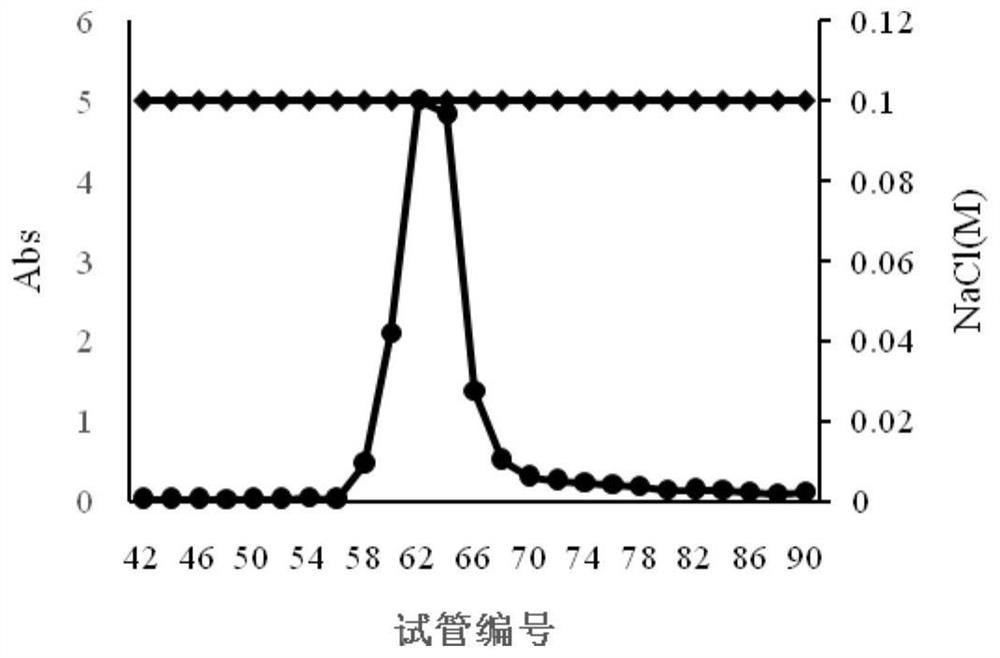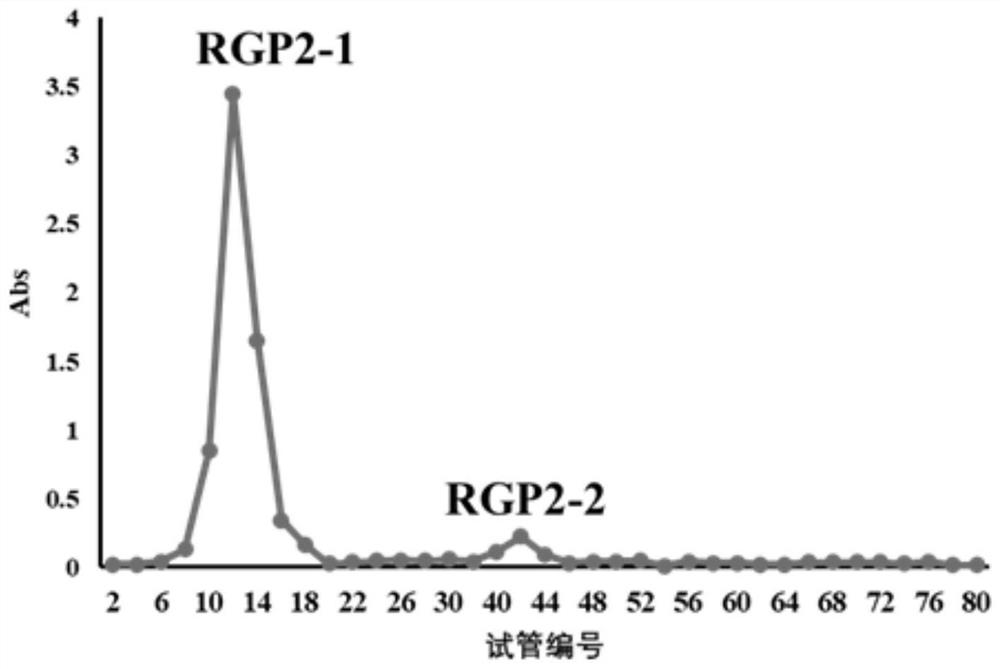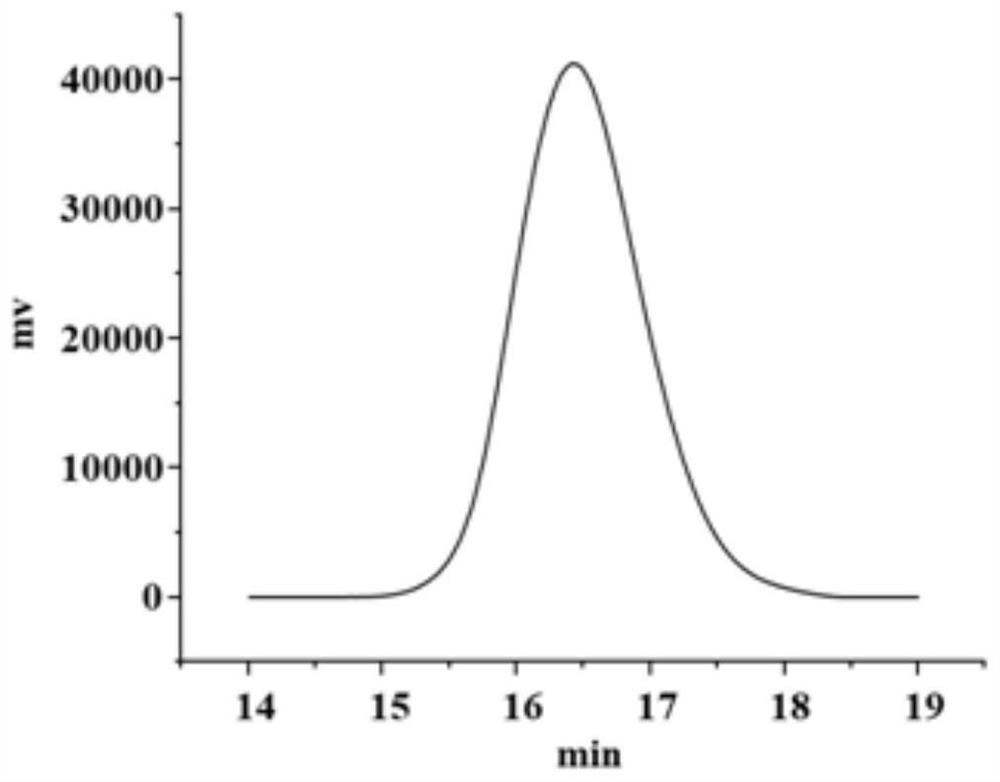Extraction, separation and purification method of red ginseng polysaccharide
A technology for separation and purification of ginseng polysaccharides, applied in the field of extraction and separation and purification of red ginseng polysaccharides, can solve problems such as unclear structure, low purity of red ginseng polysaccharides, unclear physical and chemical properties, etc. The effect of high protein efficiency
- Summary
- Abstract
- Description
- Claims
- Application Information
AI Technical Summary
Problems solved by technology
Method used
Image
Examples
Embodiment 1
[0045] The method for extracting and separating and purifying red ginseng polysaccharides from red ginseng comprises the following steps:
[0046] Step (1), raw material pretreatment: according to the mass volume ratio of red ginseng decoction pieces and petroleum ether (60-90°C) is 1:4 (m / v, g:mL), add petroleum ether to red ginseng decoction pieces, let stand 12h for degreasing treatment to remove petroleum ether, dry the red ginseng decoction pieces, and smash into red ginseng particles with a size of 0.1-0.2cm;
[0047] Step (2), reflux extraction: Put the red ginseng granules into the reflux extraction equipment, add pure water according to the ratio of material to liquid (m / v, g:mL) 1:15, first soak for 2 hours, then heat and reflux extraction, set the reflux The temperature of extraction is 95°C, each extraction is 2h, extraction is 2 times, each extraction is completed and filtered, and the filtrates are combined to obtain the extract;
[0048] Step (3), alcohol precipi...
Embodiment 2
[0076] Get 1g red ginseng crude polysaccharide extract (same as embodiment 1), add 10mL purified water to dissolve, according to the mass ratio of papain (same embodiment 1) and red ginseng crude polysaccharide extract be respectively 1:3, 1:5, Add protease at 1:7, heat in water bath at 65°C for 1h, heat inactivate at 100°C for 10min, then add Sevage reagent according to polysaccharide:Sevage reagent (chloroform:n-butanol-4:1)-1:4, shake, and carry out Deproteinize, centrifuge, take the supernatant, freeze-dry and measure the absorbance at 595nm by Coomassie brilliant blue method.
[0077] It can be seen from Table 1 that when the mass ratio of papain and red ginseng crude polysaccharide extract was 1:5, the protein removal rate was 80.40%, and the polysaccharide loss rate was 18.36%. Preferably, the mass ratio of papain and red ginseng crude polysaccharide extract is 1:5.
[0078] Table 3. Effect of protease dosage on protein removal rate
[0079]
Embodiment 3
[0081] Get 1g of red ginseng crude polysaccharide extract (same as Example 1), add 10mL of purified water to dissolve, add papain according to the mass ratio of papain (same as Example 1) and red ginseng crude polysaccharide extract is 1:5, 65 ℃ Heat in a water bath for 0.5, 1, and 2 hours respectively, heat inactivation at 100°C for 10 minutes, and then follow the volume ratio of red ginseng crude polysaccharide extract solution and Sevage reagent (chloroform:n-butanol=4:1v / v) to 1:4 Add Sevage reagent, oscillate, perform deproteinization treatment, centrifuge, take supernatant, freeze-dry and measure absorbance at 595nm by Coomassie brilliant blue method.
[0082] Table 4. Effect of protease dosage on protein removal rate
[0083]
PUM
| Property | Measurement | Unit |
|---|---|---|
| particle diameter | aaaaa | aaaaa |
Abstract
Description
Claims
Application Information
 Login to View More
Login to View More - Generate Ideas
- Intellectual Property
- Life Sciences
- Materials
- Tech Scout
- Unparalleled Data Quality
- Higher Quality Content
- 60% Fewer Hallucinations
Browse by: Latest US Patents, China's latest patents, Technical Efficacy Thesaurus, Application Domain, Technology Topic, Popular Technical Reports.
© 2025 PatSnap. All rights reserved.Legal|Privacy policy|Modern Slavery Act Transparency Statement|Sitemap|About US| Contact US: help@patsnap.com



